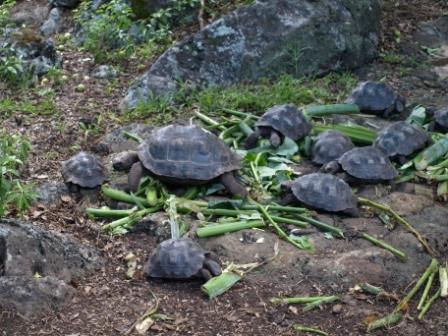Good news for tortoise lovers everywhere

VulcanSpirit
Richard & Alison Brunstrom
Thu 3 May 2012 00:53
|
Galapagos originally had at least 14 species of
tortoise. Three are thought to have gone extinct since the arrival of humans;
the others are hanging on. Humans killed tortoises in two distinct ways: firstly
directly for food. American whalers alone are recorded as having taken 100 000
tortoises in the early part of the nineteenth century (tortoises can be stored
for months in the hold of a ship without food and water and upside down so they
can't move); and secondly, by the introduction of rats and feral dogs, cats and
pigs which prey on the eggs and young, and feral goats and donkeys which
destroy the habitat.
Modern conservation efforts started after the
creation of the National Park (Ecuador's first) in 1959. It was realised that
some of the remaining tortoise species were on the brink of exinction.
Geochelone hoodensis (Espanola) was down to 14 individuals, twelve of
which were female with only two, immature, males. All were rescued and taken
into captivity. A worldwide search for Espanola tortoises in captivity was
instituted and amazingly a mature male was found in San Diego Zoo in California,
inspiringly named 'Diego'. He was repatriated and enrolled in the nascent
captive breeding programme. Luckily the tortoises have proved to be relatively
easy to breed in captivity, and Diego is now know as 'Super Diego'. He has
enabled the return of over 2000 young captive bred native tortoises to Espanola
so far.
The eggs are kept at two slightly different
temperatures (as with many reptiles, sex is determined not by genetics but
rather surprisingly by egg temperature), and the hatchlings are kept in cat- and
rat-proof cages for five years before release back to the wild.
Captive breeding has also been successful with
G.chatamensis (San Cristobal) and G. ephippium from the small
island of Pinzon where natural regeneration had ceased due to rat predation.
Here are some of the young G. chatamensis; the larger one in
the centre, about the size of an adult European tortoise, is 'Genesis', now
five years old and the first of her species to be successfully raised in
captivity.
 But it was too late for G. abingdoni
(Pinta Island), thought extinct from the early 1900s due to whalers, and habitat
destruction by 40 000 goats. Then in the 1970s a botanist working on the island
reported being approached by a tortoise. A search was organised and just one
fairly young male tortoise was found, now dubbed 'Lonesome George' - the very
last of his kind in the world. He may well live on for another hundred years,
but his species is effectively extinct. LG has taken well to captivity and is
thriving, but attempts to get him to breed with closely related tortoises from
Espanola have so far not succeeded. When females were put into his large paddock
LG went and hid in a corner, without moving - for a year! It took eleven
years before he accepted his companions properly, and there are recent signs
that LG, still relatively young, may at last be showing interest in
breeding. But so far, so desparately sad. LG is a big animal, with a large
saddleback that enables his head to reach nearly 2m off the ground. Here he is,
in the furthest corner of his corral (of course):
 But, hot news. Rumour has it that a female Pinta
tortoise has been found in captivity somewhere in the world. All is not yet lost
for G. adingdoni and LG. And even more surprising, on Wolf volcano
on Isabela a first generation Wolf/Pinta hybrid tortoise has been found - but
unfortunately a male. This means that at least one reproductively active
Pinta tortoise must be amongst the 5000 tortoises on Wolf volcano. And even more
surprisingly the Floreana tortoise, G. galapagoensis may be about to
rise from the dead. Genetic studies on Isabela by a team from Yale have found a
young tortoise that is a first generation hybrid between G.
galapagoensis and one of the Isabela species. This again means that there
is at least one reproductively active Floreana tortoise on Isabela - a
species that was thought to have gone extinct just after Darwin's visit
in 1835. Whalers are known to have moved tortoises between islands,
and in these two cases their actions just might have saved the species.
So now the hunt is on to do gentic
fingerprinting of thousands of tortoises, a concept impossible only a few years
ago such is the speed of march of science. Watch Cell Biology for
further developments!
Introduced goats, pigs, and donkeys have now been
eliminated from all the uninhabited islands, and hugely reduced everywhere.
These are the biggest removal programmes anywhere in the world, and are much to
Ecuador's credit. The future for the Galapagos tortoises looks reasonably
bright.
|